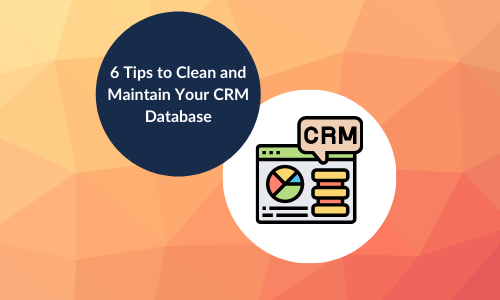
While utilizing a Customer Relationship Management software (CRM) is a quick and effective method of consolidating all your marketing contacts into one place, if left unmanaged, it can quickly become a giant cloud of disconnected data, impossible to gather beneficial information from.
Many CRMs today offer additional capabilities such as email performance, campaign tracking, sales management, and more. However, it’s important to realize that your CRM tracking and marketing performance is only effective if the data is stores is accurate and up to date.
If you don’t remember the last time your CRM data was cleaned and optimized, here are some reasons and tips to get started!
How unclean data impacts your marketing and sales results
The strength of your marketing efforts is directly tied to the health of your database.
A “healthy” database includes up-to-date and actively engaged contacts. Over time, your database health will gradually decay, becoming unusable if not corrected or optimized regularly. Information on your contacts is not usually wrong right away, but over time, people change positions, switch email addresses, or change companies all together. Data changes happen more often than you might think….
- 40% of email users change their email address at least once every two years
- 18% of all telephone numbers change every year
- 60% of people change job functions within their organization every year
Wasted time and negative ROI
Inaccurate data can have a huge impact on the ROI of your marketing campaigns and waste hours of your marketing and sales teams’ time chasing unqualified leads. In fact, a DiscoverOrg study found that sales and marketing departments lose around 550 hours and up to $32,000 per sales rep due to inaccurate data.
Negative brand perception
If your marketing and sales initiatives involve the use of personalization, which it should, inaccurate data could lead to flawed interactions with your marketing and sales teams, thus creating a negative brand perception in the eye of the prospect.
For example, a contact accidently fills out your contact for incorrectly, putting their first name as “S” instead of “Samantha”. When you send them a personalized marketing email and address them as “S”, they may see red flags. Contacts rarely remember or realize if they made a data entry mistake and instead, view it as poor customer service or spammy behavior by your company. People like to receive personalized content, but if you personalize the wrong way, it can reduce your company’s validity in their eyes.
Inheriting bad data
While most data starts out as marketing data, eventually the same data is used by your sales and customer service teams as well. Sales teams will have a difficult time appealing to prospective customers if they have inaccurate data. Additionally, it may be harder to turn marketing leads into sales lead or customers with bad data.
To avoid and limit the impact of bad data on your business and teams, consider implementing data qualify initiatives designed to clean your database regularly.
Things to consider before you start
Cleaning and optimizing your CRM data is not a one and done solution. Data is constantly changing, which means you need a proactive, routine approach to data cleansing. Depending on the size of your database, consider monthly or quarterly cleansings to keep your data up to date.
If your current database has not been cleaned in years….the initial cleansing task could take several hours or days to complete. While this can seem daunting, the following quarterly or monthly clean ups will be far less time consuming. If you set the framework and proper prevention measures, your data cleansing process will get easier and more automatic over time.
In most cases, it is also beneficial to get buy in and support from your marketing and sales teams, especially if you will be altering their current process for adding and updating information in the CRM. Work with your teams to create the most efficient and effective process for maintaining an optimized and accurate database.
Tips to clean your database
While simple data cleansing is improving the data quality of your CRM database, these tips also include preventative measures you can use to reduce the amount of missing or redundant data you collect.
1. Adjust formatting
Inconsistent formatting of your data has the most impact when you use personalization in your marketing and sales initiatives. For example, some names might be all lowercase, all uppercase, have extra spaces at the end of them, etc. These issues seem minor, but capitalization errors are immediately noticed by users and show that your company lacks attention to detail.
Formatting inconsistencies can also highly impact how well you can report on your data. If you have several data fields that are set as “text boxes”, you have no control over the format of the data inputted into those fields. A very common example of this is “State”. You might have some data points that read “Iowa” and others that read “IA”. But with reporting, there is no way to easily combine both variations.
Luckily, both types of formatting issues are easy to resolve.
If your CRM allows you to bulk export your contact database, you’ll want to do so for correcting any formatting issues. Using simple Excel functions, you can adjust the formatting of all current data to be aligned and consistent.
Moving forward, for data fields like the State example, you’ll likely want to alter the input type to a drop down list or another form of selection. This allows you to maintain control over the formatting as new data is created and make it easy to utilize in reporting and marketing segmentation. Leaving your form fields as text boxes opens your CRM up to user errors and inconsistencies with punctuation, letter case, spellings, and more.
2. Consolidate duplicate or redundant properties
Many CRMs come equipped with hundreds of ready to use properties or data fields. What tends to happen though, is as your organization’s teams start using the platform and discover data points you need to gather, new properties get created. The problem is, some of these newly created properties are redundant or duplicates of what was already available or created.
Now you end up with data split between different properties; it’s the same information but might be under a different name between contact to contact. This makes it hard to find information on each contact and makes it more difficult to use the data in reporting or segmentation.
To resolve these issues, you’ll want to start by pulling a list of all your available data properties and how many contacts have information in this property. Understanding how much data is included in each property will help you determine if it can simply be deleted, or if the information needs to be transferred to a different property.
With your list in hand, identify all the properties you wish to merge. Remember to alter the input type if necessary to avoid the use of text boxes when selection options would be a better fit. For any properties you wish to merge, you’ll need to establish one as the primary under which you will transfer all the information to. The process of merging property information will be easiest if you can bulk export your list of contacts and use imports to update their property information.
3. Merge duplicate records
Duplicate contact records are a common occurrence in CRMs and can make it difficult to find the right information on a lead and make it more challenging to qualify leads if their information is spread across different records.
A few ways duplicate contacts can be created is when:
- Someone uploads a contact list without using the appropriate unique identifiers
- Contacts are manually added without checking their existence first
- Contact forms are set up to always create a new contact, even if they have filled out a form on your site before
Many CRM platform, such as HubSpot, include built-in functionalities to identify duplicated contacts and make it easy for you to merge them without losing any valuable data.
4. Remove or suppress outdated, bounced, and unengaged contacts
Keeping contacts you either cannot email or have not engaged with your content over a given time frame can harm your marketing efforts and waste your sales team’s time. If a contact’s email has hard bounced, and it’s not due to a spelling error (i.e., gmal.com instead of gmail.com), you have no way of contacting them (outside of possibly phone number). It is not always worth it to keep these types of contacts within your database.
Similarly, unengaged contacts include any contacts who have received about 11 marketing emails from your organization but have not opened any (the criteria for unengaged can vary per CRM or company). While you do not necessarily have to remove them from your database, you should consider marking them as unengaged or suppressed. This allows you to market to them differently and avoid potentially harming your email health reputation by emailing unengaged contacts.
5. Create standard practices for data entry
One of the most common causes of missing or inconsistent data is with the data entry process. This includes what information needs to be gathered at each stage of the buyer’s journey as well as the format of the data. If there is information you need to have from a prospect before you can schedule a discovery call, make sure to include that property as a required form field. Is there information your sales team should provide when creating contacts? Make sure to use required properties in contact creation within your CRM. Doing so will allow you to take some control over what information is gathered and when.
6. Invest in data cleansing technology
Remember, data cleansing is not a one-and-done solution and will routinely take some form of manual action on your end to maintain. However, utilizing data cleansing technology, such as HubSpot Operations Hub or ZoomInfo, can turn some of those manual efforts into automated, routine tasks.
HubSpot Operations Hub
HubSpot’s Operations Hub is designed to clean and connect data and keep your processes efficient. With features like data sync, programmable automation, and data quality tools, you have the power to keep all your connected apps in sync and eliminate time consuming data cleanup tasks. You can set up automations that quickly correct data properties, format names, and more with many out of the box automations and choices.
ZoomInfo
ZoomInfo is known for their contact and company database with a 99% accuracy, but there is so much more you can do outside of pulling contact lists. Using their Data Enrichment solution, you can automate the process of refreshing your outdated and incomplete data. What’s even better, is that ZoomInfo can integrate with many marketing and sales tools, including HubSpot, to make the process even simpler and automatic.
Start cleansing your CRM database
Don’t let your outdated, inaccurate CRM data prevent your marketing and sales teams from effectively targeting leads and nurturing prospects. Take the steps outlined above to start optimizing your current data and implement some preventative measures to ensure your contact database sets your teams up for success in the long run.


